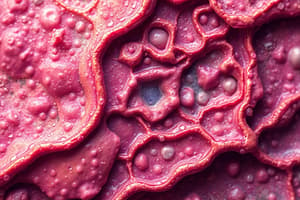Podcast
Questions and Answers
Which type of tissue is primarily responsible for movement?
Which type of tissue is primarily responsible for movement?
- Muscle Tissue (correct)
- Nervous Tissue
- Connective Tissue
- Epithelial Tissue
Epithelial tissue is highly vascular and relies on blood vessels for nutrient supply.
Epithelial tissue is highly vascular and relies on blood vessels for nutrient supply.
False (B)
What is one primary function of connective tissue?
What is one primary function of connective tissue?
Support and structure
Nervous tissue is composed of ______ and glial cells.
Nervous tissue is composed of ______ and glial cells.
Match the type of muscle with its characteristic function:
Match the type of muscle with its characteristic function:
What type of connective tissue stores fat?
What type of connective tissue stores fat?
The primary role of glial cells is to transmit electrical impulses.
The primary role of glial cells is to transmit electrical impulses.
Name one characteristic of epithelial tissue.
Name one characteristic of epithelial tissue.
Flashcards are hidden until you start studying
Study Notes
Types of Animal Tissues
-
Epithelial Tissue
- Covers body surfaces, lines cavities and organs.
- Functions in protection, absorption, secretion, and sensation.
-
Connective Tissue
- Supports, binds, and protects other tissues and organs.
- Types include loose connective, dense connective, adipose, blood, bone, and cartilage.
-
Muscle Tissue
- Responsible for movement.
- Types include skeletal (voluntary), cardiac (involuntary, heart), and smooth (involuntary, organs).
-
Nervous Tissue
- Comprises neurons and glial cells.
- Functions in transmitting signals and processing information.
Functions Of Connective Tissue
- Support and Structure: Provides frameworks for organs and tissues.
- Connection: Links different tissues and organs together.
- Protection: Cushions organs and structures (e.g., adipose tissue).
- Storage: Stores energy (fat) and minerals (bones).
- Transport: Blood transports nutrients, gases, and waste products.
- Immune Response: Contains cells that defend against pathogens (e.g., blood leukocytes).
Structure Of Epithelial Tissue
- Cellularity: Composed of closely packed cells with minimal extracellular matrix.
- Polarity: Has an apical (top) surface and a basal (bottom) surface.
- Basement Membrane: Anchors epithelial tissue to underlying connective tissue.
- Avascular: Lacks blood vessels; nutrients diffuse from underlying tissues.
- Regeneration: High capacity for renewal and repair.
Nervous Tissue Role
- Signal Transmission: Neurons transmit electrical impulses for communication.
- Processing Information: Integrates sensory input and coordinates responses.
- Support Functions: Glial cells support, nourish, and protect neurons.
- Homeostasis Regulation: Helps maintain internal balance through feedback mechanisms.
Muscle Tissue Characteristics
- Contractility: Ability to shorten and generate force.
- Excitability: Responds to stimuli (e.g., nerve impulses).
- Elasticity: Can return to original shape after stretching.
- Types:
- Skeletal Muscle: Striated, voluntary, multinucleated, attached to bones.
- Cardiac Muscle: Striated, involuntary, branched, found in the heart.
- Smooth Muscle: Non-striated, involuntary, found in walls of hollow organs.
Types of Animal Tissues
- Epithelial Tissue: Serves as a protective layer, covering body surfaces and lining cavities and organs; functions include absorption, secretion, and sensation.
- Connective Tissue: Provides support and binding for organs; encompasses various types such as loose connective, dense connective, adipose, blood, bone, and cartilage, each with specific roles.
- Muscle Tissue: Facilitates movement; consists of three types:
- Skeletal Muscle: Voluntary control, striated structure, multinuclated, connected to bones.
- Cardiac Muscle: Involuntary, striated, branched, located in the heart.
- Smooth Muscle: Involuntary, non-striated, present in the walls of hollow organs.
- Nervous Tissue: Made up of neurons and glial cells, responsible for transmitting signals and processing information.
Functions of Connective Tissue
- Support and Structure: Forms frameworks for organs, allowing them to maintain shape.
- Connection: Links various tissues and organs, facilitating communication and cohesion.
- Protection: Cushions organs (e.g., fat from adipose tissue) against trauma.
- Storage: Serves as an energy reserve (fats) and stores minerals (in bones).
- Transport: Blood plays a critical role in transporting nutrients, gases, and waste within the body.
- Immune Response: Houses cells (like leukocytes) that defend against pathogens.
Structure of Epithelial Tissue
- Cellularity: Characterized by tightly packed cells, with little extracellular matrix in-between.
- Polarity: Displays distinct apical (top) and basal (bottom) surfaces for specialized functions.
- Basement Membrane: Anchors epithelial layers to the underlying connective tissue, providing support.
- Avascular: Lacks blood vessels, relying on diffusion from adjacent tissues for nourishment.
- Regeneration: Exhibits a high capacity for renewal and repair, essential for maintaining function.
Nervous Tissue Role
- Signal Transmission: Neurons generate and transmit electrical impulses for communication across the nervous system.
- Processing Information: Integrates incoming sensory information and coordinates appropriate responses.
- Support Functions: Glial cells nourish, protect, and support the functions of neurons.
- Homeostasis Regulation: Assists in maintaining internal balance through regulatory feedback mechanisms.
Muscle Tissue Characteristics
- Contractility: Exhibits the ability to shorten and develop force, crucial for movement.
- Excitability: Capable of responding to stimuli such as nerve impulses.
- Elasticity: Able to return to its original form after being stretched.
Studying That Suits You
Use AI to generate personalized quizzes and flashcards to suit your learning preferences.



